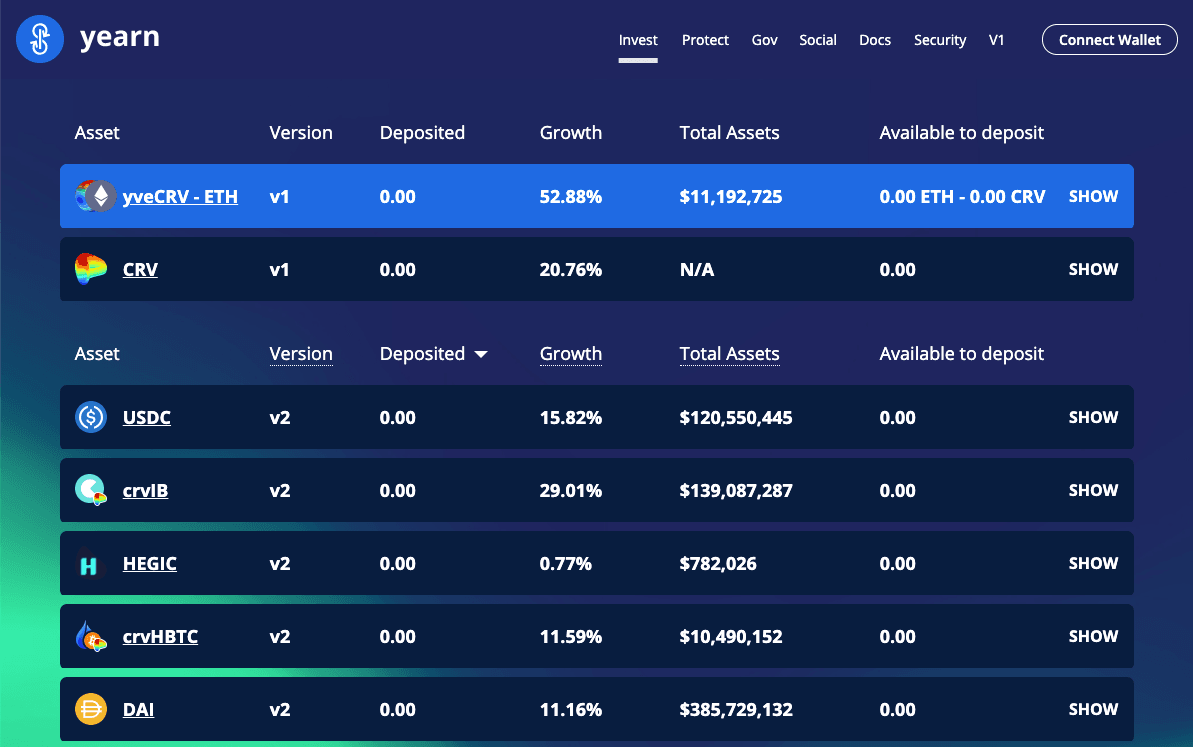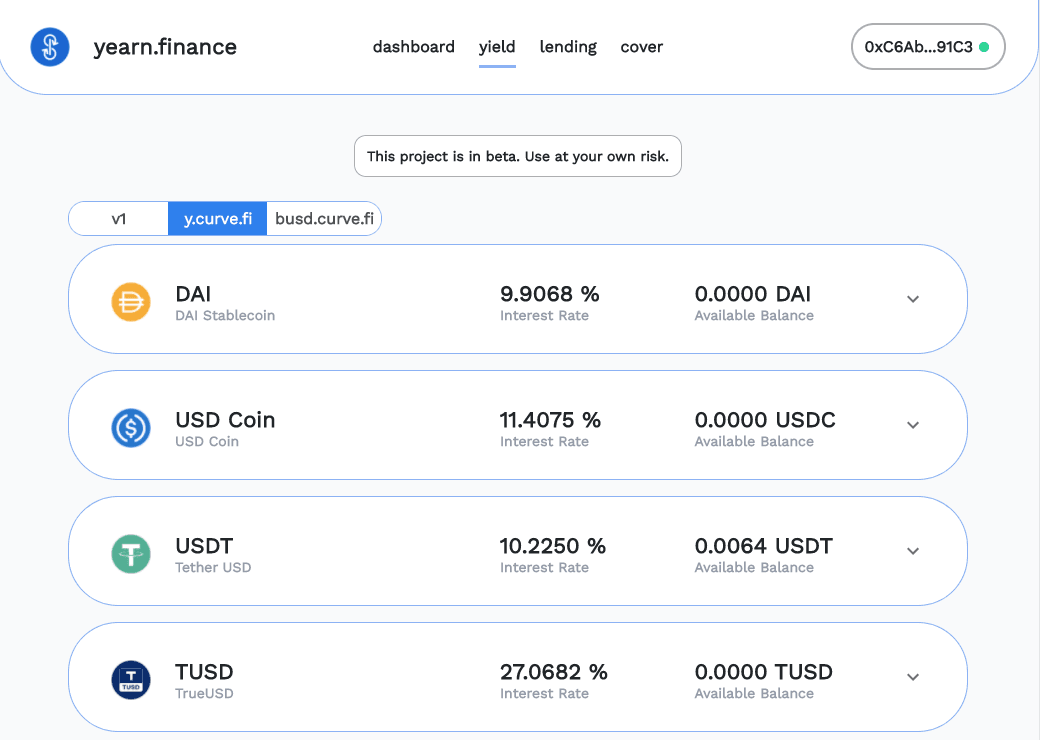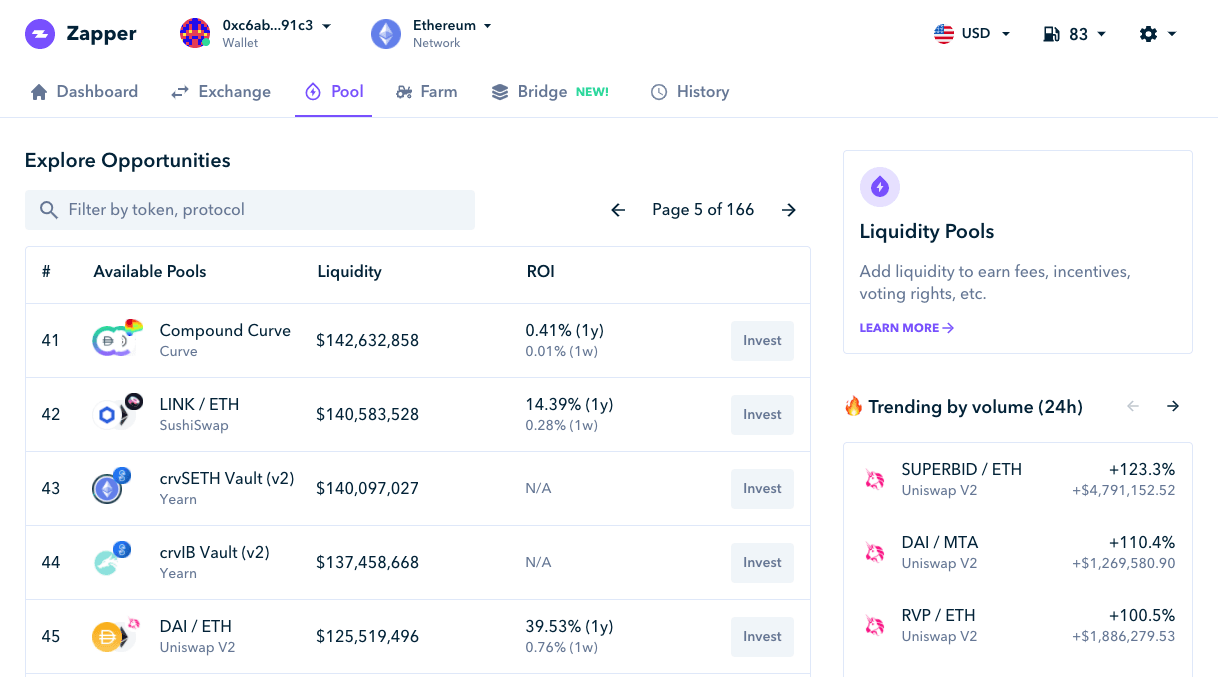Yearn Finance is an Ethereum-based DeFi protocol that provides services such as yield farming, lending and insurance. It is best known for its Vaults, which allow users to deposit cryptocurrency in order to earn interest. The funds in each Vault are pooled together and then deposited into various DeFi protocols such as decentralised exchanges to provide liquidity, in a process known as yield farming.
The Yearn protocol automatically switches funds between various protocols in order to try and get the best rate of return for users. This prevents users from having to chase yields themselves, as well as eliminating gas fees that they would have to pay if they did it themselves, which can be as high as $40 per transaction during busy periods. As a result, Yearn simplifies and automates the yield farming process for users.
Must read
Yearn and other DeFi protocols are experimental works in progress. Funds deposited into Yearn or DeFi protocols in general can be at risk of smart contract vulnerabilities, malicious developers and hacks. Yearn Finance is governed by token holders through a DAO (decentralised autonomous organisation).
What is Yearn Finance?
Yearn Finance acts as an aggregator for various DeFi products where you can deposit crypto assets to earn interest. It is governed by holders of its native token, YFI.
Launched in July 2020, Yearn was created by developer Andre Cronje and was originally named iEarn. The protocol was rebranded as yEarn finance in the latter half of 2020 after iEarn became a victim of a smart contract hack in February 2020.
YFI is the native token of the protocol and provides holders with a cut of the platform’s fee revenue as well as voting rights over the governance of Yearn. YFI governance can be quite lucrative, as demonstrated by token holders voting for themselves to receive a larger portion of the platform’s fees.
Accordingly, YFI has quickly become one of the largest DeFi tokens and has brought a lot of attention to the protocol – which rose from having $8 million in assets under management (AUM) to having over $400 million in the first week after the token’s launch.
Yearn’s yield is a floating rate rather than a fixed one, which means that the interest you earn on deposits is constantly changing along with market conditions. This is different to something like a bank, which usually gives you a fixed rate on deposits.
Deposited funds are automatically moved between protocols like dYdX, Aave and Compound based on whichever offers better interest rates. Initially, Yearn offered four major USD tokens: DAI, USDC, USDT and TUSD. It later collaborated with Curve Finance to launch yield-bearing USD token pools. It also has collaborations with SushiSwap, Cover, Cream and Pickle.
Yearn Finance currently has five core products: Vaults, Earn, Zap, Cover and Gift.
How do you use Yearn Vaults?
yVaults is the most popular product on Yearn. Vaults are pools of user funds that are managed by automated strategies, allowing you to maximise your gains without having to do the hard work of switching between various yield farming strategies yourself.
When you deposit funds, you will automatically receive a yToken. This represents your share of funds in the Vault (also known as a liquidity pool) and is used to redeem your funds when you want to take them back out of the pool – similar to the way that you receive a receipt when you check in your jacket at a cloakroom. yTokens are automatically deposited into the same Ethereum address you used to make the deposit.

The Vaults section of Yearn displaying the current interest rate and funds of each Vault
The strategies used in Vaults are more dynamic than those of the standard yearn protocol and are developed by the token holders who are part of the Yearn community. yVaults put the user deposits to work on different DeFi protocols, such as providing liquidity to decentralised exchanges or providing collateral for loans. Earnings from one protocol are then compounded as they are re-invested into subsequent DeFi protocols.
These vaults eliminate the high gas fees of transacting on Ethereum for the pool, as only a single account pays fees, instead of each individual user.
You can use your yTokens to redeem your deposited funds at any time, in addition to the yields you earn from using the vault.
When withdrawing from the vault, the crypto assets can come from two sources: the Yearn Vault reserves or the active strategy vault. No fee is charged for withdrawals coming from the yVault reserves, however, when the withdrawal is sourced from an active DeFi strategy, a withdrawal fee of 0.5% is charged.
Also be aware of Ethereum gas fees, which can make depositing and withdrawing quite expensive, depending on network congestion at the time.
To make a deposit or withdrawal you will need to use a cryptocurrency wallet. Currently, Yearn supports Metamask, Trust Wallet, WalletConnet, Coinbase Wallet, Ledger, Trezor, Fortmatic, Portis, Sqaurelink, Torus and Authereum.
Cryptocurrency wallets compared
How do you use Yearn Earn?
yEarn is Yearn Finance’s lending aggregator that aims to attain the highest yield for the stablecoins deposited by users.
yEarn does this by implementing automated smart contract algorithms to shift the assets between different Ethereum lending protocols, including AAVE, dYdX and Compound, to find the highest yields. Earn is similar to Vaults but it only supports stablecoins and tokenised Bitcoin including DAI, USDC, USDT, TUSD, sUSD and wBTC.

The stablecoin Earn pools and dynamic interest rates
Yearn acts as a robo-investor by choosing and shifting between investment options in order to try and earn the maximum interest rate on your deposit. yEarn executes automated yield farming strategies through a number of lending pools across various DeFi platforms to theoretically generate maximum returns at the lowest risk possible.
The system is designed to help you earn the highest interest rate available at all times. yEarn pools earned some of the highest DeFi interest rates in 2020 and yEarn has been called the “Bitcoin of DeFi” for the high APY generated for its early users.
yEarn also created Curve’s popular Y pool consisting of top stablecoins including DAI, USDC, USDT and TUSD, and it’s used for the BUSD Curve pool.
How do you use Zap?
Zap is a helpful tool that allows users to engage with DeFi products (in this case, Yearn) with “one click” by automating transactions. Sometimes depositing funds into a Yearn smart contract requires multiple steps, which Zap bundles into a single click. Doing so saves you both time and gas fees.
For example, if you hold ETH and enter yVault, you will need to convert your ETH into YFI, then approve the YFI and, as a third step, deposit YFI. Each of these steps is a separate on-chain transaction that incurs both fees and time. Zap instead bundles all of these into a single process.
The service is provided by Zapper.fi, which is an all-in-one DeFi routing service and aggregator.

Users can also access Yearn services from the Zapper.fi dashboard
Additionally, various assets such as DAI, USDC, USDT, TUSD and BUSD can be zapped into Curve.fi pools. Through these, users can zap out of Curve Finance tokens to get stablecoins in exchange. It is also possible to swap between ETH and DAI.
How do yTokens work and what can you use them for?
As discussed earlier, yTokens are generated when you deposit your cryptocurrency into a liquidity pool, representing your share of the liquidity pool. It’s similar to the way a bank gives you a receipt when you make a cash deposit.
For example, if you deposit DAI into a liquidity pool, you will receive yDAI (a yToken) in return. The automated algorithm then seeks out the highest yielding APR oracle and will move the pooled DAI to the respective protocol. If the pool generates a profit, your yDAI will increase in value, as it represents your share of the pool. When you withdraw from the pool, the yDAI tokens will be burned and you will get back the amount of DAI tokens you deposited plus any profit earned.
yTokens are ERC-20 tokens and can be transferred and traded like any other ETH token.
How does the YFI token work?
YFI Coin is the governance token of the Yearn Finance protocol. It can be used to vote for changes and other decisions in the protocol and its products.
YFI holders can also stake their coins to earn a portion of the fees collected from the Yearn Finance platform.
YFI has a circulating supply of 36,000 and the total supply is currently limited to 36,700 tokens, although token holders may vote to change this if they wish. The token was officially launched on 17 July 2020, when 30,000 tokens were airdropped to the protocol’s early users as a surprise.
YFI can be purchased and traded on any one of the exchanges in the table below.
Are you visiting from outside the US?
What are the risks of using Yearn Finance?
Yearn Finance created a lot of buzz immediately after its launch, due to the innovative automation algorithm, which aims to choose the best yields amongst the DeFi protocols.
Vaults are Yearn’s most popular product and are what drove the platform to its current status. In addition to benefiting users financially, pooling assets via Yearn provides liquidity for exchanges, allows users to borrow funds and even underwrites insurance risk.
Despite the user appeal that Yearn has as a protocol, it has been a victim of exploits and hacks. After the YFI token launch in July 2020, it was hacked in September, when $15 million was stolen by a hacker who exploited a smart contract vulnerability. However, $8 million of this amount was returned to a wallet owned by Andre Cronje, the developer of Yearn.
In February 2021, Yearn Finance’s DAI vault was hacked using an Aave flash loan and drained of $11 million worth of assets from various contracts. The protocol then had to open a Maker Vault with YFI tokens from its newly expanded treasury to repay the defrauded users.
As such, Yearn remains an experimental product and a work in progress. You should understand that any funds deposited into Yearn or DeFi protocols in general are at risk due to things like smart contract vulnerabilities, malicious developers and hacks.
Whether products shown are available to you is subject to individual provider sole approval and discretion in accordance with the eligibility criteria and T&Cs on the provider website.
Ask a question
More guides on Finder
-
List of the biggest crypto hacks
Learn about some major crypto hacks and what you can do to protect yourself.
-
How to buy Chainlink (LINK)
This guide provides step-by-step instructions on how to buy Chainlink, lists some exchanges where you can get it and provides daily price data on (LINK).
-
Binance Coin (BNB) Price Prediction 2025
A panel of industry specialists give us their predictions on the price of Binance Coin to 2035.
-
Shiba Inu (SHIB) Price Prediction 2025, 2030 & 2035
A panel of industry specialists give us their predictions on the price of shiba inu to 2035.
-
Solana (SOL) Price Prediction 2025, 2030 & 2035
A panel of industry specialists give us their predictions on the price of solana to 2035.
-
What is a stablecoin?
Stablecoin can be one way to leverage lower-risk investments for greater protection against market volatility.
-
Bitcoin (BTC) Price Prediction 2025, 2030 & 2035: April 2025 Report
A panel of industry specialists give us their predictions on the price of Bitcoin to 2035.
-
Ethereum (ETH) Price Prediction 2025, 2030 & 2035: April 2025 Report
A panel of industry specialists give us their predictions on the price of Ethereum to 2035.
-
XRP (XRP) Price Prediction 2025, 2030 & 2035
A panel of industry specialists give us their predictions on the price of XRP to 2035.
-
Finder Cryptocurrency Predictions Report April 2025
Every 3 months, Finder empanels a range of industry specialists to get a pulse on what the future holds for crypto. This is a summary of those findings.








